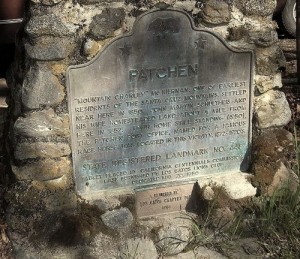 When people think about the Santa Cruz Mountains, ghost towns aren’t usually the first thing that pops in their minds.
When people think about the Santa Cruz Mountains, ghost towns aren’t usually the first thing that pops in their minds.
However, in the last half of the nineteenth century, the mountains were home to a number of booming pioneer towns and mining camps that sprung up along the stagecoach and railroad lines between Los Gatos and Santa Cruz.
Similar to nowadays, Santa Cruz’s beaches brought tourists and day-trippers in from the valley, and a number of hotels and resorts were built in the mountains in the late 1800s to cater to the crowds.
Patchen, a once-thriving community established around 1855, was a stop for the California Stage Company to change horses as it delivered the mail. Lexington started out as a sawmill in 1848, and was a stagecoach stop between Los Gatos and Santa Cruz. Another town, Wright’s Station, was an important railroad shipping point for all the agriculture, fruit, and timber businesses in the area after the railroad was completed in 1880.
With the railroad and stagecoach lines, robberies were abundant, and there were infamous murders in Lexington over gold, leading to public hangings. Large disasters like natural gas explosions in the railroad tunnels and mine collapses lead to numerous deaths, including 31 Chinese railroad workers after an explosion on the railroad line. However, this didn’t stop tourists from flocking to the area. Notable patrons of Wright’s Station include Jack London and Mark Twain.
The Legend of Mountain Charlie
Perhaps one of the most colorful characters in the Santa Cruz Mountains was Mountain Charlie, one of the first white settlers in the area. Born Charles Henry McKiernan, Mountain Charlie was a teamster, miner, rancher, lumberman, and road builder.
In 1858 the Santa Cruz Turnpike Company contracted with Mountain Charlie to build a toll road between Scotts Valley and the Summit area. What is nowadays known as “Mountain Charlie Road” was the first road to connect Los Gatos and Santa Cruz.
While he helped build the early infrastructure of the Santa Cruz Mountains, Mountain Charlie is most known for surviving a vicious grizzly bear attack. In 1854, while out hunting in the woods, a grizzly bear attacked Mountain Charlie, ripping off a five by three inch chunk of his face and skull. He had a doctor patch it up with a plate of silver made from two Mexican pesos, but he remained severely disfigured throughout the rest of his long life. Legends and folklore sprang up about Mountain Charlie and how he was able to survive such an attack. His motto throughout life was “Right Wrongs Nobody.”
The Holy City Cult
One of the more notorious ghost towns of the Santa Cruz Mountains is Holy City, located along Old Santa Cruz Highway. Holy City was established in 1919 by “Father” William Riker, an ex-fortune teller and mind-reader, and a group of about 30 cult-members.
After fleeing to Canada to escape charges of bigamy, Riker developed “The Perfect Christian Divine Way,” and preached celibacy, white supremacy, and no drinking of alcohol. Riker himself though, was exempt from the whole “no sex” thing and took a wife, and demanded that his followers, mostly little old ladies, give him all their money.
The town became a roadside attraction and tourist stop which featured a restaurant, gas station, weekly newspaper, and even its own radio station. Billboards and signs saying things like, “See us if you are completing marriage, suicide, or crime” sprung up along Old Santa Cruz Highway to entice tourists. Riker ran for governor four times, and was arrested in 1942 for writing support letters to Hitler during World War II.
Highway 17 Causes The Decline Of The Towns
In 1940, the railroad ceased operations after it suffered major damage from a winter storm, causing the decline of the towns of Laurel, Clems, Wrights Station, and Glenwood. Also in 1940, Highway 17 was built, bypassing Patchen and Holy City, and causing their eventual abandonment. After the Lexington Reservoir was created in 1952, the already abandoned towns of Lexington and Alma were submerged under water.
Nowadays, all that is left of the remaining ghost towns are a few crumbling foundations, a couple house frames, and placards marking the sites. Patchen is now home to a Christmas tree farm, while Holy City Art Glass marks the location of Riker’s cult community. The train tunnel at Wright’s Station remains, but was sealed with explosives in 1942.
With Highway 17 still the main way to connect between Los Gatos and Santa Cruz, those wanting to visit the ghost towns have to venture into the mountains and overgrown forest to find them.
TYTYTY — MM
have you seen the 1960’s hippy poster of the Holy City richfield service station
No, I haven’t seen that. Would love to though. Sounds interesting.